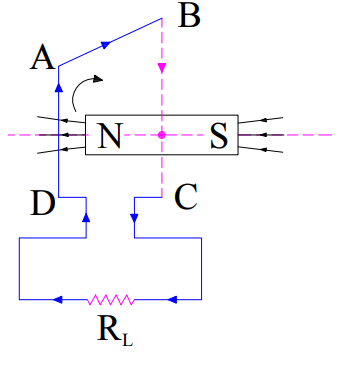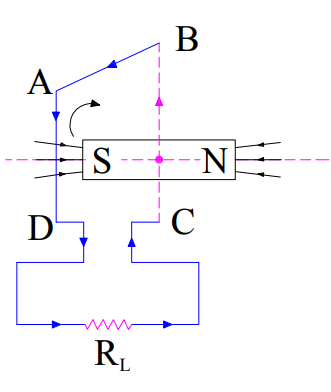Definition:
AC Generator is an electrical machine which converts mechanical energy into electrical energy. The input supply of AC Generator is mechanical energy which is supplied through some prime-mover and the output is alternating energy in the form of alternating voltage & current. In this post we will discuss AC Generator working and construction.
Construction of AC Generator:
An AC Generator essentially consists of two main parts: Stator and Rotor. Stator is the stationary part of machine whereas rotor is rotating part. A prime mover is coupled to this rotor to supply mechanical energy.
Stator:
Stator is stationary component on which armature winding is wound. Armature winding is the winding which carries load current. Here load means any device or equipment which consumes electrical power. This stator is stack of laminated steel assembled to form a cylindrical structure. Steel lamination are used to minimize the eddy current loss.
Slots for housing stator winding (armature winding) are cut along the periphery of the stator.
Rotor:
Rotor is the rotating component of AC Generator. It is also made of laminated steel. DC Field winding or exciting winding is wound on the rotor to create magnetic poles i.e. North and South Poles. This exciting winding is supplied DC current through an assembly of slip ring and carbon brush.
There are basically to designs for rotor. One is Salient Pole Rotor and another is Cylindrical Rotor.
Saliency itself means “projecting outward”. This gives some idea of design feature of salient pole rotor. In salient design, rotor poles project outward as shown below.

The field winding on salient pole rotor is concentrated winding. In Cylindrical Rotor, field winding is distributed winding.
Working Principle of AC Generator:
The basic working principle of AC Generator is based on faraday’s law. When the rotor of AC Generator is rotated by prime-mover, the magnetic flux linkage with the stationary armature winding (mounted on Stator) changes. Due to this an emf is induced in the armature winding. If load is connected, an AC current starts flowing through the load due to the induced emf. This is how an AC Generator works.
Let us consider the figure below to better understand the AC generator working principle. In the figure, a single armature winding is considered for the sake of simplicity. A permanent magnet is taken as rotor instead of rotor with field winding. Rotor is assumed to be rotating in clockwise direction.

In the above figure, the rotor field axis and armature winding axis coincides. Therefore the flux linkage is maximum at this instant of time and hence maximum emf will be induced. Consequently, maximum current will flow through the load RL. The direction of current is governed by lenz’s law. The current will flow from D-A-B-C-D.
Now, rotor is rotated further by 90 degree in clockwise direction as shown below.

At this instant, rotor axis and armature winding axis are perpendicular to each other. Therefore, there will not be any mutual coupling between them. Thus no emf will be induced in the stator (armature winding). Hence no current will flow through the load RL at this instant.
A further rotation of rotor by 90 degree causes stator axis and rotor axis to coincide again. Hence flux linkage will again be maximum. Subsequently, maximum current will flow through the load.

But there is one key difference here. In this case, the current has reversed its direction. This is just because the direction of flux linkage has reversed as can be seen from the figure. The direction of current is along C-B-A-D-C.
The analysis for further rotor rotation can easily be done in the same manner. The AC generator output current waveform with rotor position is shown below.

Thus it is clear that an AC Generator is converting mechanical energy into alternating electrical energy.
Thanks it helped me complete my physics project
Thank you! Please share if you like it.
Very great and sufficient information what a student need must.
Thanks in Advance for the such article!